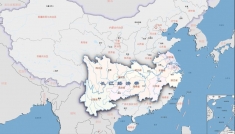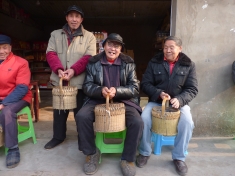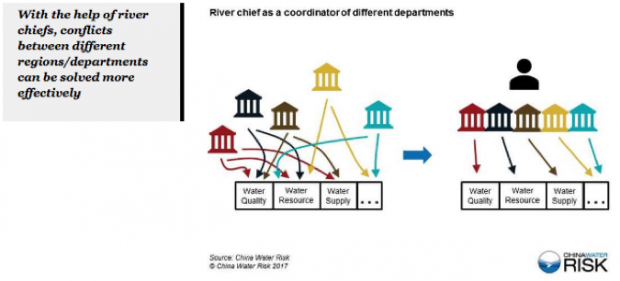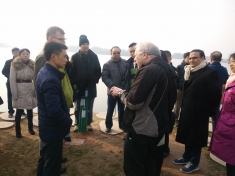China Commits to Protecting the Yangtze River
After decades of rapid development,
China commits to protecting the Yangtze
Notes from a February 2018 field trip
Headwaters of the Yangtze River, Qinghai province
Stephanie Jensen-Cormier, International Rivers
China's Yangtze River has become alarmingly polluted and dammed. Most of the ten provinces through which the Yangtze courses have experienced disruptions in the functioning of their ecosystems due to pollution and insufficient water flows.
International Rivers has advocated for the protection of the Yangtze River for decades. In 2015, together with our local partners, we helped secure protection for the last stretch of free-flowing water on the Yangtze River. We supported the Ministry of Environmental Protection to block the Xiaonanhai hydropower project by calling attention to a Nature Reserve, whose boundaries had been redrawn several times in order to make way for hydropower development.
Since then, the Chinese government has stepped up an ambitious plan to protect the Yangtze. At the end of 2017, the central government designated ecological redlines for an area that has been designated as the Yangtze River Economic Belt. Ecological redlines protect ecologically important areas. For the Yangtze, this means that heavy and chemical industry projects are prohibited within one kilometer of the Yangtze and its major tributaries. New projects are not permitted and existing ones are forced to relocate elsewhere.
In February, I joined a delegation and set out to understand how this shift in priorities is playing out in the upper reaches of the Yangtze.
Background on the Yangtze River
The Yangtze River has driven the Chinese economy throughout its history, and thus shaped the development and culture of the country. Measuring 6,300 kilometers from its headwaters in the Tibetan Plateau to where it empties into East China Sea near Shanghai, it is the third-longest river in the world and the longest to flow entirely in one country. In fact, the Yangtze's name in Chinese is Chang Jiang, which means "Long River."
The river's course splits northern China from the south, and it feeds and fuels some of China's biggest cities, including Chongqing, population 30 million (the most populous city in the country), and Shanghai, mainland China's most cosmopolitan city and an internationally-recognized business hub. Ethnic minority groups and their cultures are also connected to the Yangtze.
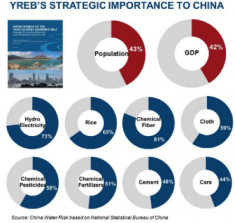
The river has allowed goods and people to flow between China's interior and its coastal cities for centuries. The Yangtze River basin covers 20% of the geographical territory of China and sustains 400 million people, or 43% of the country's population. The Yangtze River region makes up more than a third of China's freshwater reserves, contributing 42% of China's GDP and 73% of the country's hydropower. Intensive development, however, has taken its toll on China's mother river.
Recognizing this, President Xi Jinping has taken measures to conserve the river basin. In January 2016, he announced the creation of the Yangtze River Economic Belt (YREB). During the 19th Party Congress, in October 2017, the President stressed that YREB development should be protection-oriented rather than development-oriented. The YREB is critical for China to achieve a just and ecological civilization. This is music to my ears.
February 2018 visit to the Yangtze
In February 2018, I went to Chongqing and Guizhou province for five days of meetings and site visits as part of a delegation with the Asian Development Bank, the China Council for International Cooperation on Environment and Development, and other experts. The group met with the private sector, government officials and researchers in Chongqing Municipality and in Guizhou province. Many of the officials whom we met were moving quickly to implement measures to support President Xi's emphasis that "green mountains are gold mountains" and were also hoping to apply to pilot projects for good water and river management.
Chishui River, the only major free-flowing tributary of the Yangtze
While the Yangtze River and its tributaries are filled with dams, the Chishui River, at 523 km, is its only major free-flowing tributary. The Chishui basin sustains 112 fish species (28 of which are native and only found in the area) and provides habitat for at least 1,700 types of plants and more than 350 types of animals, of which about 70 are protected nationally.The Chishui traverses Yunnan, Sichuan and Guizhou provinces, and 60% of the river is in Guizhou. The Chishui River is the site for major historical events and "hero stories" related to the Red Army. In Guizhou, it has supported several famous Chinese liquor brands along its banks. It is also known as the "River of Intoxicating Liquors." Officials in Guizhou intend for the Chishui River to become a pilot for advancing ecological civilization.
Key corporations rely on healthy rivers
The "River of Intoxicating Liquors" has long been important to local people, government and businesses. In Zunyi municipality (Guizhou province). We met with a senior representative of the famous luxury Moutai liquor brand. The Moutai Group and officials from the town know that the health of the Chishui River directly impacts their business. Local officials told me that "good water makes good Moutai." Moutai Group has been investing RMB 50 million (nearly USD $8 million) annually in the town's development and the Chishui basin's protection-though I'm not sure about the breakdown or allocation.
Local officials say that there's an urgent need for economic development and poverty reduction in the area. They see potential to boost tourism due to the cultural significance and natural beauty of the karst landscapes, and the fame of Moutai. This is why Guizhou is keen to expand efforts to protect the river and to conserve and rehabilitate the river basin.
Improvements in health and water quality of rivers
China's Liangping District (in the north of Chongqing) has a population of 900,000, 200,000 of whom are of prime working age and go out to work in other provinces. As we drove into Liangping, we could see orchards of pomelos, a popular product from the area. The officials explained that the older generations grow the pomelo and that they traditionally don't use pesticides. Indeed, it is clear that many of the people in the district live traditional lives: We saw older men and women carrying around little thatch baskets with twigs and simple biomass fuels to keep themselves warm.
Officials from Liangping District brought our delegation to visit the Liangping River, where poverty reduction and ecological improvements sometimes find themselves at odds. Officials from the Environmental Protection Bureau explained that in the past year, in order to improve the quality of this river, they had forced the closures of hundreds of small-scale pig and chicken farms. While they report that these measures have addressed point-source pollution and significantly improved the water quality, the fate of the affected farmers remains unclear; officials did not clarify whether the compensation provided adequate support to those impacted. If impacted individuals and businesses are not trained or supported to find other business opportunities, they might reopen once there is less monitoring or might set up elsewhere and contaminate other water bodies or land.
River Chiefs in action
The River Chiefs system is new. River Chiefs are employees of the government who have additional responsibilities related to water resource protection, pollution control and ecological restoration. Xinhua News reports that 200,000 River Chiefs have been assigned since summer 2017. Along the Liangping River we saw a billboard with information about the River Chiefs for this segment of the river at the provincial, city, county and township levels. The billboard included telephone numbers to report any infractions of water pollution or contamination. QR codes are universally used in China, and there is a QR code for an app that introduces the River Chiefs system and makes it easy to report and document violations captured in cell phone photos.
Building a "Beautiful China"
The slogan "Beautiful China" ties a good environment to a sense of national pride. President Xi aims to make much progress towards building a "Beautiful China" by 2035. President Xi explains that China "should, acting on the principles of prioritizing resource conservation and environmental protection and letting nature restore itself, develop spatial layouts, industrial structures, and ways of work and life that help conserve resources and protect the environment. With this, we can restore the serenity, harmony, and beauty of nature."
The intention to restore the "serenity, harmony and beauty of nature" can take interesting shapes. The Shangui Lake Project is a wetland restoration area in a man-made reservoir that we visited in Chongqing. The project aims to create good and healthy working and living environments for people while protecting the wetland system that has developed in this man-made reservoir. The park includes complex shorelines of wooden bridge pathways mixed with reeds. This kind of space is helpful in accommodating humans, wild birds, fish and other mammals.
People generally value access to beautiful environments in their neighbourhoods. These spaces play an important role in developing an appreciation for beautiful environments.
Outlook
In the coming months, it is widely anticipated that the Chinese government will announce the creation of a new top-level body to manage state owned natural resource assets and the environment. This will be a breakthrough, since currently Chinese ministries have unclear and overlapping divisions of responsibilities and compete to manage the country's water resources and rivers. The new, ministerial-level body is expected to be oriented towards protecting ecosystems and ecological conservation rather than exploiting to developing the economy.
It is likely that provinces will collaborate with each other to introduce multi-provincial ecological-compensation systems. Eco-compensation seeks to compensate land users or suppliers of ecosystem services for lost income or land use rights due to environmental protection policies. China's 12th (2011-2015) and 13th (2016-2020) Five-Year plans specifically refer to the development and application of eco-compensation in order to achieve an ecological civilization. Eco-compensation also features in the 2002 Water Law.
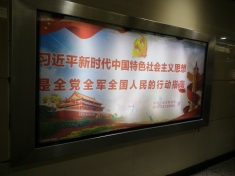
In early February, 2018, officials from various Chinese provinces attended a national forum on eco-compensation. Back in 2009 Guizhou was one of the first provinces to introduce an ecological compensation system through which RMB 300 million (over $47 million) has been distributed. For example, every year, an upstream city (Bijie) receives compensation of about RMB 10 million in return for ensuring clean water for downstream reaches. While Guizhou, Sichuan and Yunnan are all creating their own eco-compensation mechanisms, they need greater coordination for shared resources like the Chishui River. These coordinated actions will likely then serve as models that can be exported to other parts of the country. It will be important for the provinces to ensure that the coordinated eco-compensation mechanisms are sustainable in the longer term.
Conclusion
The Chinese government is fundamentally shifting how it looks at the Yangtze River. An official in Guizhou explained that the province needs to "promote ecology first, before green development." In his 19th Party Congress address, President Xi commented that "any harm on nature will return to haunt us." How China governs and manages the Yangtze River will determine the fate of the Chinese nation. A "Beautiful China" needs free-flowing rivers and to do so, it must tread carefully and engage with multiple stakeholders including corporations, all levels of government, NGOs and civil society. International Rivers' Strategic Plan features permanent river protection prominently. We're pleased that the Chinese government also recognizes the importance of this work.

